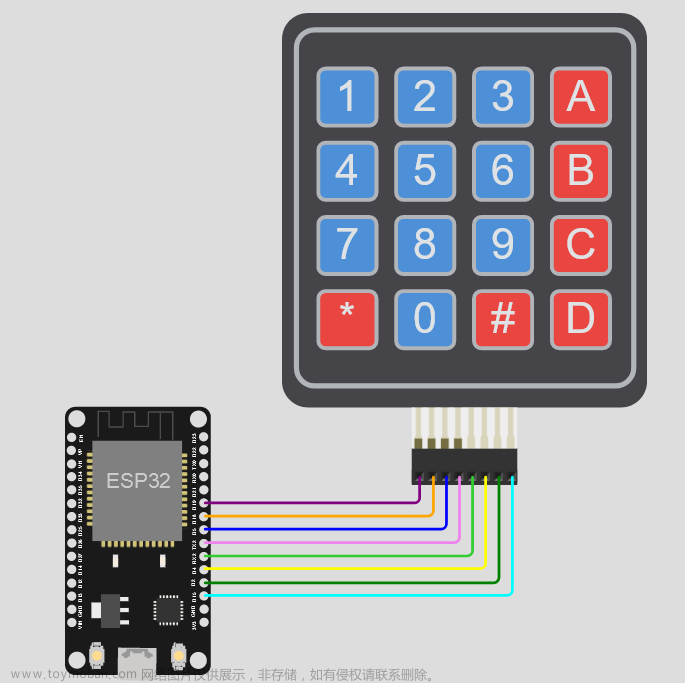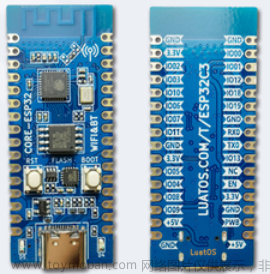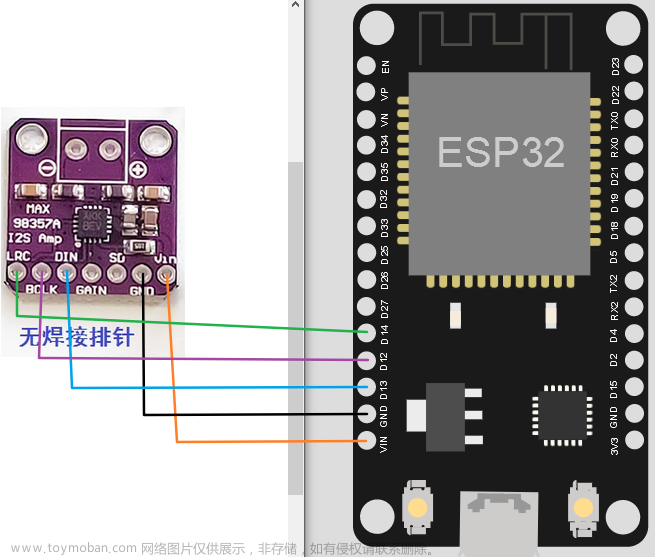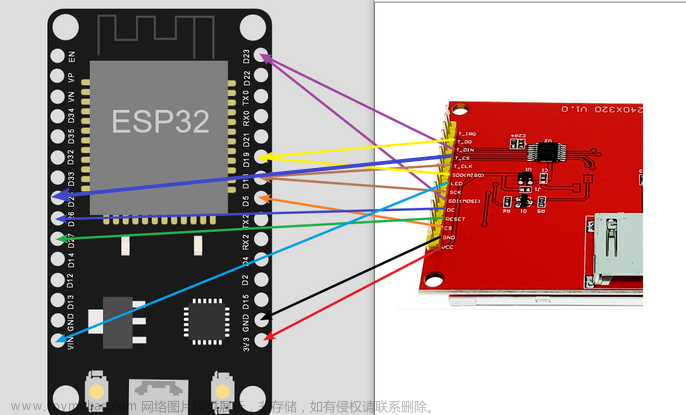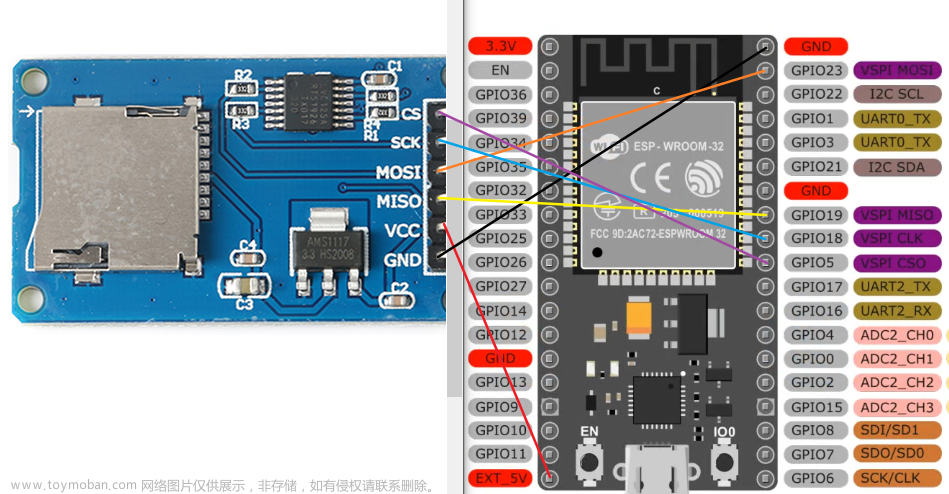一、目的
这一节我们学习如何使用ESP32开发板,通过串口SPI控制ILI9341 液晶屏。我使用的是3.2寸的,分辨率240x320 V1.0,TFT屏幕。文末有购买地址。
二、环境
ESP32(固件:esp32-20220618-v1.19.1.bin) + Thonny(V4.0.1) + ILI9341 液晶屏模块 + 几根杜邦线 + Win10 64位商业版
以前也介绍过这个屏幕,大家请参考我这个文章:
物联网开发笔记(62)- 使用Micropython开发ESP32开发板之控制ILI9341 3.2寸TFT-LCD触摸屏进行LVGL图形化编程:环境搭建_micropython lvgl_魔都飘雪的博客-CSDN博客使用Micropython开发ESP32开发板之控制ILI9341 3.2寸TFT-LCD触摸屏进行LVGL图形化编程:环境搭建https://blog.csdn.net/zhusongziye/article/details/128321793?spm=1001.2014.3001.5501 今天使用的是一种新的开发方法,大家按如下方式接线哈:
| ILI9341屏幕 | ESP32开发板 | |
| VCC | 5V或3.3V | |
| GND | GND | |
| CS | D5 | |
| RESET | D27 | |
| DC | D26 | |
| SDI(MOSI) | D23 | |
| SCK | D18 | |
| LED | D2 | 接5V为最亮 |
| SDO(MISO) | D19 | |
| T_CLK | D18 | |
| T_CS | D25 | |
| T_DIN | D23 | |
| T_OUT | D19 | |
| T_IRQ | 不连接 |
三、Thonny操作技巧
在开发板中新建目录:


把电脑本地的文件传到开发板中的文件夹中:


字库下载地址:
链接: https://pan.baidu.com/s/18uPePotSSV62NmeZSRCDNQ 提取码: 5wzy 复制这段内容后打开百度网盘手机App,操作更方便哦
四、屏幕点亮示例程序
先分享一下ili9341屏幕的驱动:
"""ILI9341 LCD/Touch module."""
from time import sleep
from math import cos, sin, pi, radians
from sys import implementation
from framebuf import FrameBuffer, RGB565 # type: ignore
import ustruct # type: ignore
def color565(r, g, b):
"""Return RGB565 color value.
Args:
r (int): Red value.
g (int): Green value.
b (int): Blue value.
"""
return (r & 0xf8) << 8 | (g & 0xfc) << 3 | b >> 3
class Display(object):
"""Serial interface for 16-bit color (5-6-5 RGB) IL9341 display.
Note: All coordinates are zero based.
"""
# Command constants from ILI9341 datasheet
NOP = const(0x00) # No-op
SWRESET = const(0x01) # Software reset
RDDID = const(0x04) # Read display ID info
RDDST = const(0x09) # Read display status
SLPIN = const(0x10) # Enter sleep mode
SLPOUT = const(0x11) # Exit sleep mode
PTLON = const(0x12) # Partial mode on
NORON = const(0x13) # Normal display mode on
RDMODE = const(0x0A) # Read display power mode
RDMADCTL = const(0x0B) # Read display MADCTL
RDPIXFMT = const(0x0C) # Read display pixel format
RDIMGFMT = const(0x0D) # Read display image format
RDSELFDIAG = const(0x0F) # Read display self-diagnostic
INVOFF = const(0x20) # Display inversion off
INVON = const(0x21) # Display inversion on
GAMMASET = const(0x26) # Gamma set
DISPLAY_OFF = const(0x28) # Display off
DISPLAY_ON = const(0x29) # Display on
SET_COLUMN = const(0x2A) # Column address set
SET_PAGE = const(0x2B) # Page address set
WRITE_RAM = const(0x2C) # Memory write
READ_RAM = const(0x2E) # Memory read
PTLAR = const(0x30) # Partial area
VSCRDEF = const(0x33) # Vertical scrolling definition
MADCTL = const(0x36) # Memory access control
VSCRSADD = const(0x37) # Vertical scrolling start address
PIXFMT = const(0x3A) # COLMOD: Pixel format set
WRITE_DISPLAY_BRIGHTNESS = const(0x51) # Brightness hardware dependent!
READ_DISPLAY_BRIGHTNESS = const(0x52)
WRITE_CTRL_DISPLAY = const(0x53)
READ_CTRL_DISPLAY = const(0x54)
WRITE_CABC = const(0x55) # Write Content Adaptive Brightness Control
READ_CABC = const(0x56) # Read Content Adaptive Brightness Control
WRITE_CABC_MINIMUM = const(0x5E) # Write CABC Minimum Brightness
READ_CABC_MINIMUM = const(0x5F) # Read CABC Minimum Brightness
FRMCTR1 = const(0xB1) # Frame rate control (In normal mode/full colors)
FRMCTR2 = const(0xB2) # Frame rate control (In idle mode/8 colors)
FRMCTR3 = const(0xB3) # Frame rate control (In partial mode/full colors)
INVCTR = const(0xB4) # Display inversion control
DFUNCTR = const(0xB6) # Display function control
PWCTR1 = const(0xC0) # Power control 1
PWCTR2 = const(0xC1) # Power control 2
PWCTRA = const(0xCB) # Power control A
PWCTRB = const(0xCF) # Power control B
VMCTR1 = const(0xC5) # VCOM control 1
VMCTR2 = const(0xC7) # VCOM control 2
RDID1 = const(0xDA) # Read ID 1
RDID2 = const(0xDB) # Read ID 2
RDID3 = const(0xDC) # Read ID 3
RDID4 = const(0xDD) # Read ID 4
GMCTRP1 = const(0xE0) # Positive gamma correction
GMCTRN1 = const(0xE1) # Negative gamma correction
DTCA = const(0xE8) # Driver timing control A
DTCB = const(0xEA) # Driver timing control B
POSC = const(0xED) # Power on sequence control
ENABLE3G = const(0xF2) # Enable 3 gamma control
PUMPRC = const(0xF7) # Pump ratio control
ROTATE = {
0: 0x88,
90: 0xE8,
180: 0x48,
270: 0x28
}
def __init__(self, spi, cs, dc, rst,
width=240, height=320, rotation=0):
"""Initialize OLED.
Args:
spi (Class Spi): SPI interface for OLED
cs (Class Pin): Chip select pin
dc (Class Pin): Data/Command pin
rst (Class Pin): Reset pin
width (Optional int): Screen width (default 240)
height (Optional int): Screen height (default 320)
rotation (Optional int): Rotation must be 0 default, 90. 180 or 270
"""
self.spi = spi
self.cs = cs
self.dc = dc
self.rst = rst
self.width = width
self.height = height
if rotation not in self.ROTATE.keys():
raise RuntimeError('Rotation must be 0, 90, 180 or 270.')
else:
self.rotation = self.ROTATE[rotation]
# Initialize GPIO pins and set implementation specific methods
if implementation.name == 'circuitpython':
self.cs.switch_to_output(value=True)
self.dc.switch_to_output(value=False)
self.rst.switch_to_output(value=True)
self.reset = self.reset_cpy
self.write_cmd = self.write_cmd_cpy
self.write_data = self.write_data_cpy
else:
self.cs.init(self.cs.OUT, value=1)
self.dc.init(self.dc.OUT, value=0)
self.rst.init(self.rst.OUT, value=1)
self.reset = self.reset_mpy
self.write_cmd = self.write_cmd_mpy
self.write_data = self.write_data_mpy
self.reset()
# Send initialization commands
self.write_cmd(self.SWRESET) # Software reset
sleep(.1)
self.write_cmd(self.PWCTRB, 0x00, 0xC1, 0x30) # Pwr ctrl B
self.write_cmd(self.POSC, 0x64, 0x03, 0x12, 0x81) # Pwr on seq. ctrl
self.write_cmd(self.DTCA, 0x85, 0x00, 0x78) # Driver timing ctrl A
self.write_cmd(self.PWCTRA, 0x39, 0x2C, 0x00, 0x34, 0x02) # Pwr ctrl A
self.write_cmd(self.PUMPRC, 0x20) # Pump ratio control
self.write_cmd(self.DTCB, 0x00, 0x00) # Driver timing ctrl B
self.write_cmd(self.PWCTR1, 0x23) # Pwr ctrl 1
self.write_cmd(self.PWCTR2, 0x10) # Pwr ctrl 2
self.write_cmd(self.VMCTR1, 0x3E, 0x28) # VCOM ctrl 1
self.write_cmd(self.VMCTR2, 0x86) # VCOM ctrl 2
self.write_cmd(self.MADCTL, self.rotation) # Memory access ctrl
self.write_cmd(self.VSCRSADD, 0x00) # Vertical scrolling start address
self.write_cmd(self.PIXFMT, 0x55) # COLMOD: Pixel format
self.write_cmd(self.FRMCTR1, 0x00, 0x18) # Frame rate ctrl
self.write_cmd(self.DFUNCTR, 0x08, 0x82, 0x27)
self.write_cmd(self.ENABLE3G, 0x00) # Enable 3 gamma ctrl
self.write_cmd(self.GAMMASET, 0x01) # Gamma curve selected
self.write_cmd(self.GMCTRP1, 0x0F, 0x31, 0x2B, 0x0C, 0x0E, 0x08, 0x4E,
0xF1, 0x37, 0x07, 0x10, 0x03, 0x0E, 0x09, 0x00)
self.write_cmd(self.GMCTRN1, 0x00, 0x0E, 0x14, 0x03, 0x11, 0x07, 0x31,
0xC1, 0x48, 0x08, 0x0F, 0x0C, 0x31, 0x36, 0x0F)
self.write_cmd(self.SLPOUT) # Exit sleep
sleep(.1)
self.write_cmd(self.DISPLAY_ON) # Display on
sleep(.1)
self.clear()
def block(self, x0, y0, x1, y1, data):
"""Write a block of data to display.
Args:
x0 (int): Starting X position.
y0 (int): Starting Y position.
x1 (int): Ending X position.
y1 (int): Ending Y position.
data (bytes): Data buffer to write.
"""
self.write_cmd(self.SET_COLUMN, *ustruct.pack(">HH", x0, x1))
self.write_cmd(self.SET_PAGE, *ustruct.pack(">HH", y0, y1))
self.write_cmd(self.WRITE_RAM)
self.write_data(data)
def cleanup(self):
"""Clean up resources."""
self.clear()
self.display_off()
self.spi.deinit()
print('display off')
def clear(self, color=0):
"""Clear display.
Args:
color (Optional int): RGB565 color value (Default: 0 = Black).
"""
w = self.width
h = self.height
# Clear display in 1024 byte blocks
if color:
line = color.to_bytes(2, 'big') * (w * 8)
else:
line = bytearray(w * 16)
for y in range(0, h, 8):
self.block(0, y, w - 1, y + 7, line)
def display_off(self):
"""Turn display off."""
self.write_cmd(self.DISPLAY_OFF)
def display_on(self):
"""Turn display on."""
self.write_cmd(self.DISPLAY_ON)
def draw_circle(self, x0, y0, r, color):
"""Draw a circle.
Args:
x0 (int): X coordinate of center point.
y0 (int): Y coordinate of center point.
r (int): Radius.
color (int): RGB565 color value.
"""
f = 1 - r
dx = 1
dy = -r - r
x = 0
y = r
self.draw_pixel(x0, y0 + r, color)
self.draw_pixel(x0, y0 - r, color)
self.draw_pixel(x0 + r, y0, color)
self.draw_pixel(x0 - r, y0, color)
while x < y:
if f >= 0:
y -= 1
dy += 2
f += dy
x += 1
dx += 2
f += dx
self.draw_pixel(x0 + x, y0 + y, color)
self.draw_pixel(x0 - x, y0 + y, color)
self.draw_pixel(x0 + x, y0 - y, color)
self.draw_pixel(x0 - x, y0 - y, color)
self.draw_pixel(x0 + y, y0 + x, color)
self.draw_pixel(x0 - y, y0 + x, color)
self.draw_pixel(x0 + y, y0 - x, color)
self.draw_pixel(x0 - y, y0 - x, color)
def draw_ellipse(self, x0, y0, a, b, color):
"""Draw an ellipse.
Args:
x0, y0 (int): Coordinates of center point.
a (int): Semi axis horizontal.
b (int): Semi axis vertical.
color (int): RGB565 color value.
Note:
The center point is the center of the x0,y0 pixel.
Since pixels are not divisible, the axes are integer rounded
up to complete on a full pixel. Therefore the major and
minor axes are increased by 1.
"""
a2 = a * a
b2 = b * b
twoa2 = a2 + a2
twob2 = b2 + b2
x = 0
y = b
px = 0
py = twoa2 * y
# Plot initial points
self.draw_pixel(x0 + x, y0 + y, color)
self.draw_pixel(x0 - x, y0 + y, color)
self.draw_pixel(x0 + x, y0 - y, color)
self.draw_pixel(x0 - x, y0 - y, color)
# Region 1
p = round(b2 - (a2 * b) + (0.25 * a2))
while px < py:
x += 1
px += twob2
if p < 0:
p += b2 + px
else:
y -= 1
py -= twoa2
p += b2 + px - py
self.draw_pixel(x0 + x, y0 + y, color)
self.draw_pixel(x0 - x, y0 + y, color)
self.draw_pixel(x0 + x, y0 - y, color)
self.draw_pixel(x0 - x, y0 - y, color)
# Region 2
p = round(b2 * (x + 0.5) * (x + 0.5) +
a2 * (y - 1) * (y - 1) - a2 * b2)
while y > 0:
y -= 1
py -= twoa2
if p > 0:
p += a2 - py
else:
x += 1
px += twob2
p += a2 - py + px
self.draw_pixel(x0 + x, y0 + y, color)
self.draw_pixel(x0 - x, y0 + y, color)
self.draw_pixel(x0 + x, y0 - y, color)
self.draw_pixel(x0 - x, y0 - y, color)
def draw_hline(self, x, y, w, color):
"""Draw a horizontal line.
Args:
x (int): Starting X position.
y (int): Starting Y position.
w (int): Width of line.
color (int): RGB565 color value.
"""
if self.is_off_grid(x, y, x + w - 1, y):
return
line = color.to_bytes(2, 'big') * w
self.block(x, y, x + w - 1, y, line)
def draw_image(self, path, x=0, y=0, w=320, h=240):
"""Draw image from flash.
Args:
path (string): Image file path.
x (int): X coordinate of image left. Default is 0.
y (int): Y coordinate of image top. Default is 0.
w (int): Width of image. Default is 320.
h (int): Height of image. Default is 240.
"""
x2 = x + w - 1
y2 = y + h - 1
if self.is_off_grid(x, y, x2, y2):
return
with open(path, "rb") as f:
chunk_height = 1024 // w
chunk_count, remainder = divmod(h, chunk_height)
chunk_size = chunk_height * w * 2
chunk_y = y
if chunk_count:
for c in range(0, chunk_count):
buf = f.read(chunk_size)
self.block(x, chunk_y,
x2, chunk_y + chunk_height - 1,
buf)
chunk_y += chunk_height
if remainder:
buf = f.read(remainder * w * 2)
self.block(x, chunk_y,
x2, chunk_y + remainder - 1,
buf)
def draw_letter(self, x, y, letter, font, color, background=0,
landscape=False):
"""Draw a letter.
Args:
x (int): Starting X position.
y (int): Starting Y position.
letter (string): Letter to draw.
font (XglcdFont object): Font.
color (int): RGB565 color value.
background (int): RGB565 background color (default: black).
landscape (bool): Orientation (default: False = portrait)
"""
buf, w, h = font.get_letter(letter, color, background, landscape)
# Check for errors (Font could be missing specified letter)
if w == 0:
return w, h
if landscape:
y -= w
if self.is_off_grid(x, y, x + h - 1, y + w - 1):
return 0, 0
self.block(x, y,
x + h - 1, y + w - 1,
buf)
else:
if self.is_off_grid(x, y, x + w - 1, y + h - 1):
return 0, 0
self.block(x, y,
x + w - 1, y + h - 1,
buf)
return w, h
def draw_line(self, x1, y1, x2, y2, color):
"""Draw a line using Bresenham's algorithm.
Args:
x1, y1 (int): Starting coordinates of the line
x2, y2 (int): Ending coordinates of the line
color (int): RGB565 color value.
"""
# Check for horizontal line
if y1 == y2:
if x1 > x2:
x1, x2 = x2, x1
self.draw_hline(x1, y1, x2 - x1 + 1, color)
return
# Check for vertical line
if x1 == x2:
if y1 > y2:
y1, y2 = y2, y1
self.draw_vline(x1, y1, y2 - y1 + 1, color)
return
# Confirm coordinates in boundary
if self.is_off_grid(min(x1, x2), min(y1, y2),
max(x1, x2), max(y1, y2)):
return
# Changes in x, y
dx = x2 - x1
dy = y2 - y1
# Determine how steep the line is
is_steep = abs(dy) > abs(dx)
# Rotate line
if is_steep:
x1, y1 = y1, x1
x2, y2 = y2, x2
# Swap start and end points if necessary
if x1 > x2:
x1, x2 = x2, x1
y1, y2 = y2, y1
# Recalculate differentials
dx = x2 - x1
dy = y2 - y1
# Calculate error
error = dx >> 1
ystep = 1 if y1 < y2 else -1
y = y1
for x in range(x1, x2 + 1):
# Had to reverse HW ????
if not is_steep:
self.draw_pixel(x, y, color)
else:
self.draw_pixel(y, x, color)
error -= abs(dy)
if error < 0:
y += ystep
error += dx
def draw_lines(self, coords, color):
"""Draw multiple lines.
Args:
coords ([[int, int],...]): Line coordinate X, Y pairs
color (int): RGB565 color value.
"""
# Starting point
x1, y1 = coords[0]
# Iterate through coordinates
for i in range(1, len(coords)):
x2, y2 = coords[i]
self.draw_line(x1, y1, x2, y2, color)
x1, y1 = x2, y2
def draw_pixel(self, x, y, color):
"""Draw a single pixel.
Args:
x (int): X position.
y (int): Y position.
color (int): RGB565 color value.
"""
if self.is_off_grid(x, y, x, y):
return
self.block(x, y, x, y, color.to_bytes(2, 'big'))
def draw_polygon(self, sides, x0, y0, r, color, rotate=0):
"""Draw an n-sided regular polygon.
Args:
sides (int): Number of polygon sides.
x0, y0 (int): Coordinates of center point.
r (int): Radius.
color (int): RGB565 color value.
rotate (Optional float): Rotation in degrees relative to origin.
Note:
The center point is the center of the x0,y0 pixel.
Since pixels are not divisible, the radius is integer rounded
up to complete on a full pixel. Therefore diameter = 2 x r + 1.
"""
coords = []
theta = radians(rotate)
n = sides + 1
for s in range(n):
t = 2.0 * pi * s / sides + theta
coords.append([int(r * cos(t) + x0), int(r * sin(t) + y0)])
# Cast to python float first to fix rounding errors
self.draw_lines(coords, color=color)
def draw_rectangle(self, x, y, w, h, color):
"""Draw a rectangle.
Args:
x (int): Starting X position.
y (int): Starting Y position.
w (int): Width of rectangle.
h (int): Height of rectangle.
color (int): RGB565 color value.
"""
x2 = x + w - 1
y2 = y + h - 1
self.draw_hline(x, y, w, color)
self.draw_hline(x, y2, w, color)
self.draw_vline(x, y, h, color)
self.draw_vline(x2, y, h, color)
def draw_sprite(self, buf, x, y, w, h):
"""Draw a sprite (optimized for horizontal drawing).
Args:
buf (bytearray): Buffer to draw.
x (int): Starting X position.
y (int): Starting Y position.
w (int): Width of drawing.
h (int): Height of drawing.
"""
x2 = x + w - 1
y2 = y + h - 1
if self.is_off_grid(x, y, x2, y2):
return
self.block(x, y, x2, y2, buf)
def draw_text(self, x, y, text, font, color, background=0,
landscape=False, spacing=1):
"""Draw text.
Args:
x (int): Starting X position.
y (int): Starting Y position.
text (string): Text to draw.
font (XglcdFont object): Font.
color (int): RGB565 color value.
background (int): RGB565 background color (default: black).
landscape (bool): Orientation (default: False = portrait)
spacing (int): Pixels between letters (default: 1)
"""
for letter in text:
# Get letter array and letter dimensions
w, h = self.draw_letter(x, y, letter, font, color, background,
landscape)
# Stop on error
if w == 0 or h == 0:
print('Invalid width {0} or height {1}'.format(w, h))
return
if landscape:
# Fill in spacing
if spacing:
self.fill_hrect(x, y - w - spacing, h, spacing, background)
# Position y for next letter
y -= (w + spacing)
else:
# Fill in spacing
if spacing:
self.fill_hrect(x + w, y, spacing, h, background)
# Position x for next letter
x += (w + spacing)
# # Fill in spacing
# if spacing:
# self.fill_vrect(x + w, y, spacing, h, background)
# # Position x for next letter
# x += w + spacing
def draw_text8x8(self, x, y, text, color, background=0,
rotate=0):
"""Draw text using built-in MicroPython 8x8 bit font.
Args:
x (int): Starting X position.
y (int): Starting Y position.
text (string): Text to draw.
color (int): RGB565 color value.
background (int): RGB565 background color (default: black).
rotate(int): 0, 90, 180, 270
"""
w = len(text) * 8
h = 8
# Confirm coordinates in boundary
if self.is_off_grid(x, y, x + 7, y + 7):
return
# Rearrange color
r = (color & 0xF800) >> 8
g = (color & 0x07E0) >> 3
b = (color & 0x1F) << 3
buf = bytearray(w * 16)
fbuf = FrameBuffer(buf, w, h, RGB565)
if background != 0:
bg_r = (background & 0xF800) >> 8
bg_g = (background & 0x07E0) >> 3
bg_b = (background & 0x1F) << 3
fbuf.fill(color565(bg_b, bg_r, bg_g))
fbuf.text(text, 0, 0, color565(b, r, g))
if rotate == 0:
self.block(x, y, x + w - 1, y + (h - 1), buf)
elif rotate == 90:
buf2 = bytearray(w * 16)
fbuf2 = FrameBuffer(buf2, h, w, RGB565)
for y1 in range(h):
for x1 in range(w):
fbuf2.pixel(y1, x1,
fbuf.pixel(x1, (h - 1) - y1))
self.block(x, y, x + (h - 1), y + w - 1, buf2)
elif rotate == 180:
buf2 = bytearray(w * 16)
fbuf2 = FrameBuffer(buf2, w, h, RGB565)
for y1 in range(h):
for x1 in range(w):
fbuf2.pixel(x1, y1,
fbuf.pixel((w - 1) - x1, (h - 1) - y1))
self.block(x, y, x + w - 1, y + (h - 1), buf2)
elif rotate == 270:
buf2 = bytearray(w * 16)
fbuf2 = FrameBuffer(buf2, h, w, RGB565)
for y1 in range(h):
for x1 in range(w):
fbuf2.pixel(y1, x1,
fbuf.pixel((w - 1) - x1, y1))
self.block(x, y, x + (h - 1), y + w - 1, buf2)
def draw_vline(self, x, y, h, color):
"""Draw a vertical line.
Args:
x (int): Starting X position.
y (int): Starting Y position.
h (int): Height of line.
color (int): RGB565 color value.
"""
# Confirm coordinates in boundary
if self.is_off_grid(x, y, x, y + h - 1):
return
line = color.to_bytes(2, 'big') * h
self.block(x, y, x, y + h - 1, line)
def fill_circle(self, x0, y0, r, color):
"""Draw a filled circle.
Args:
x0 (int): X coordinate of center point.
y0 (int): Y coordinate of center point.
r (int): Radius.
color (int): RGB565 color value.
"""
f = 1 - r
dx = 1
dy = -r - r
x = 0
y = r
self.draw_vline(x0, y0 - r, 2 * r + 1, color)
while x < y:
if f >= 0:
y -= 1
dy += 2
f += dy
x += 1
dx += 2
f += dx
self.draw_vline(x0 + x, y0 - y, 2 * y + 1, color)
self.draw_vline(x0 - x, y0 - y, 2 * y + 1, color)
self.draw_vline(x0 - y, y0 - x, 2 * x + 1, color)
self.draw_vline(x0 + y, y0 - x, 2 * x + 1, color)
def fill_ellipse(self, x0, y0, a, b, color):
"""Draw a filled ellipse.
Args:
x0, y0 (int): Coordinates of center point.
a (int): Semi axis horizontal.
b (int): Semi axis vertical.
color (int): RGB565 color value.
Note:
The center point is the center of the x0,y0 pixel.
Since pixels are not divisible, the axes are integer rounded
up to complete on a full pixel. Therefore the major and
minor axes are increased by 1.
"""
a2 = a * a
b2 = b * b
twoa2 = a2 + a2
twob2 = b2 + b2
x = 0
y = b
px = 0
py = twoa2 * y
# Plot initial points
self.draw_line(x0, y0 - y, x0, y0 + y, color)
# Region 1
p = round(b2 - (a2 * b) + (0.25 * a2))
while px < py:
x += 1
px += twob2
if p < 0:
p += b2 + px
else:
y -= 1
py -= twoa2
p += b2 + px - py
self.draw_line(x0 + x, y0 - y, x0 + x, y0 + y, color)
self.draw_line(x0 - x, y0 - y, x0 - x, y0 + y, color)
# Region 2
p = round(b2 * (x + 0.5) * (x + 0.5) +
a2 * (y - 1) * (y - 1) - a2 * b2)
while y > 0:
y -= 1
py -= twoa2
if p > 0:
p += a2 - py
else:
x += 1
px += twob2
p += a2 - py + px
self.draw_line(x0 + x, y0 - y, x0 + x, y0 + y, color)
self.draw_line(x0 - x, y0 - y, x0 - x, y0 + y, color)
def fill_hrect(self, x, y, w, h, color):
"""Draw a filled rectangle (optimized for horizontal drawing).
Args:
x (int): Starting X position.
y (int): Starting Y position.
w (int): Width of rectangle.
h (int): Height of rectangle.
color (int): RGB565 color value.
"""
if self.is_off_grid(x, y, x + w - 1, y + h - 1):
return
chunk_height = 1024 // w
chunk_count, remainder = divmod(h, chunk_height)
chunk_size = chunk_height * w
chunk_y = y
if chunk_count:
buf = color.to_bytes(2, 'big') * chunk_size
for c in range(0, chunk_count):
self.block(x, chunk_y,
x + w - 1, chunk_y + chunk_height - 1,
buf)
chunk_y += chunk_height
if remainder:
buf = color.to_bytes(2, 'big') * remainder * w
self.block(x, chunk_y,
x + w - 1, chunk_y + remainder - 1,
buf)
def fill_rectangle(self, x, y, w, h, color):
"""Draw a filled rectangle.
Args:
x (int): Starting X position.
y (int): Starting Y position.
w (int): Width of rectangle.
h (int): Height of rectangle.
color (int): RGB565 color value.
"""
if self.is_off_grid(x, y, x + w - 1, y + h - 1):
return
if w > h:
self.fill_hrect(x, y, w, h, color)
else:
self.fill_vrect(x, y, w, h, color)
def fill_polygon(self, sides, x0, y0, r, color, rotate=0):
"""Draw a filled n-sided regular polygon.
Args:
sides (int): Number of polygon sides.
x0, y0 (int): Coordinates of center point.
r (int): Radius.
color (int): RGB565 color value.
rotate (Optional float): Rotation in degrees relative to origin.
Note:
The center point is the center of the x0,y0 pixel.
Since pixels are not divisible, the radius is integer rounded
up to complete on a full pixel. Therefore diameter = 2 x r + 1.
"""
# Determine side coordinates
coords = []
theta = radians(rotate)
n = sides + 1
for s in range(n):
t = 2.0 * pi * s / sides + theta
coords.append([int(r * cos(t) + x0), int(r * sin(t) + y0)])
# Starting point
x1, y1 = coords[0]
# Minimum Maximum X dict
xdict = {y1: [x1, x1]}
# Iterate through coordinates
for row in coords[1:]:
x2, y2 = row
xprev, yprev = x2, y2
# Calculate perimeter
# Check for horizontal side
if y1 == y2:
if x1 > x2:
x1, x2 = x2, x1
if y1 in xdict:
xdict[y1] = [min(x1, xdict[y1][0]), max(x2, xdict[y1][1])]
else:
xdict[y1] = [x1, x2]
x1, y1 = xprev, yprev
continue
# Non horizontal side
# Changes in x, y
dx = x2 - x1
dy = y2 - y1
# Determine how steep the line is
is_steep = abs(dy) > abs(dx)
# Rotate line
if is_steep:
x1, y1 = y1, x1
x2, y2 = y2, x2
# Swap start and end points if necessary
if x1 > x2:
x1, x2 = x2, x1
y1, y2 = y2, y1
# Recalculate differentials
dx = x2 - x1
dy = y2 - y1
# Calculate error
error = dx >> 1
ystep = 1 if y1 < y2 else -1
y = y1
# Calcualte minimum and maximum x values
for x in range(x1, x2 + 1):
if is_steep:
if x in xdict:
xdict[x] = [min(y, xdict[x][0]), max(y, xdict[x][1])]
else:
xdict[x] = [y, y]
else:
if y in xdict:
xdict[y] = [min(x, xdict[y][0]), max(x, xdict[y][1])]
else:
xdict[y] = [x, x]
error -= abs(dy)
if error < 0:
y += ystep
error += dx
x1, y1 = xprev, yprev
# Fill polygon
for y, x in xdict.items():
self.draw_hline(x[0], y, x[1] - x[0] + 2, color)
def fill_vrect(self, x, y, w, h, color):
"""Draw a filled rectangle (optimized for vertical drawing).
Args:
x (int): Starting X position.
y (int): Starting Y position.
w (int): Width of rectangle.
h (int): Height of rectangle.
color (int): RGB565 color value.
"""
if self.is_off_grid(x, y, x + w - 1, y + h - 1):
return
chunk_width = 1024 // h
chunk_count, remainder = divmod(w, chunk_width)
chunk_size = chunk_width * h
chunk_x = x
if chunk_count:
buf = color.to_bytes(2, 'big') * chunk_size
for c in range(0, chunk_count):
self.block(chunk_x, y,
chunk_x + chunk_width - 1, y + h - 1,
buf)
chunk_x += chunk_width
if remainder:
buf = color.to_bytes(2, 'big') * remainder * h
self.block(chunk_x, y,
chunk_x + remainder - 1, y + h - 1,
buf)
def is_off_grid(self, xmin, ymin, xmax, ymax):
"""Check if coordinates extend past display boundaries.
Args:
xmin (int): Minimum horizontal pixel.
ymin (int): Minimum vertical pixel.
xmax (int): Maximum horizontal pixel.
ymax (int): Maximum vertical pixel.
Returns:
boolean: False = Coordinates OK, True = Error.
"""
if xmin < 0:
print('x-coordinate: {0} below minimum of 0.'.format(xmin))
return True
if ymin < 0:
print('y-coordinate: {0} below minimum of 0.'.format(ymin))
return True
if xmax >= self.width:
print('x-coordinate: {0} above maximum of {1}.'.format(
xmax, self.width - 1))
return True
if ymax >= self.height:
print('y-coordinate: {0} above maximum of {1}.'.format(
ymax, self.height - 1))
return True
return False
def load_sprite(self, path, w, h):
"""Load sprite image.
Args:
path (string): Image file path.
w (int): Width of image.
h (int): Height of image.
Notes:
w x h cannot exceed 2048
"""
buf_size = w * h * 2
with open(path, "rb") as f:
return f.read(buf_size)
def reset_cpy(self):
"""Perform reset: Low=initialization, High=normal operation.
Notes: CircuitPython implemntation
"""
self.rst.value = False
sleep(.05)
self.rst.value = True
sleep(.05)
def reset_mpy(self):
"""Perform reset: Low=initialization, High=normal operation.
Notes: MicroPython implemntation
"""
self.rst(0)
sleep(.05)
self.rst(1)
sleep(.05)
def scroll(self, y):
"""Scroll display vertically.
Args:
y (int): Number of pixels to scroll display.
"""
self.write_cmd(self.VSCRSADD, y >> 8, y & 0xFF)
def set_scroll(self, top, bottom):
"""Set the height of the top and bottom scroll margins.
Args:
top (int): Height of top scroll margin
bottom (int): Height of bottom scroll margin
"""
if top + bottom <= self.height:
middle = self.height - (top + bottom)
print(top, middle, bottom)
self.write_cmd(self.VSCRDEF,
top >> 8,
top & 0xFF,
middle >> 8,
middle & 0xFF,
bottom >> 8,
bottom & 0xFF)
def sleep(self, enable=True):
"""Enters or exits sleep mode.
Args:
enable (bool): True (default)=Enter sleep mode, False=Exit sleep
"""
if enable:
self.write_cmd(self.SLPIN)
else:
self.write_cmd(self.SLPOUT)
def write_cmd_mpy(self, command, *args):
"""Write command to OLED (MicroPython).
Args:
command (byte): ILI9341 command code.
*args (optional bytes): Data to transmit.
"""
self.dc(0)
self.cs(0)
self.spi.write(bytearray([command]))
self.cs(1)
# Handle any passed data
if len(args) > 0:
self.write_data(bytearray(args))
def write_cmd_cpy(self, command, *args):
"""Write command to OLED (CircuitPython).
Args:
command (byte): ILI9341 command code.
*args (optional bytes): Data to transmit.
"""
self.dc.value = False
self.cs.value = False
# Confirm SPI locked before writing
while not self.spi.try_lock():
pass
self.spi.write(bytearray([command]))
self.spi.unlock()
self.cs.value = True
# Handle any passed data
if len(args) > 0:
self.write_data(bytearray(args))
def write_data_mpy(self, data):
"""Write data to OLED (MicroPython).
Args:
data (bytes): Data to transmit.
"""
self.dc(1)
self.cs(0)
self.spi.write(data)
self.cs(1)
def write_data_cpy(self, data):
"""Write data to OLED (CircuitPython).
Args:
data (bytes): Data to transmit.
"""
self.dc.value = True
self.cs.value = False
# Confirm SPI locked before writing
while not self.spi.try_lock():
pass
self.spi.write(data)
self.spi.unlock()
self.cs.value = True
演示代码:
from machine import Pin,SPI
from ili9341 import Display,color565
import time
spi = SPI(2, baudrate=80000000, polarity=0, phase=0, bits=8, firstbit=0, sck=Pin(18), mosi=Pin(23), miso=Pin(19))
tft = Display(spi,cs=Pin(5,Pin.OUT),dc=Pin(26,Pin.OUT),rst=Pin(27,Pin.OUT),width=240,height=320,rotation=180)
def main():
tft.clear(color565(255,0,0))
while true:
pass
if __name__ == "__main__":
main()显示效果为,屏幕填充为红色
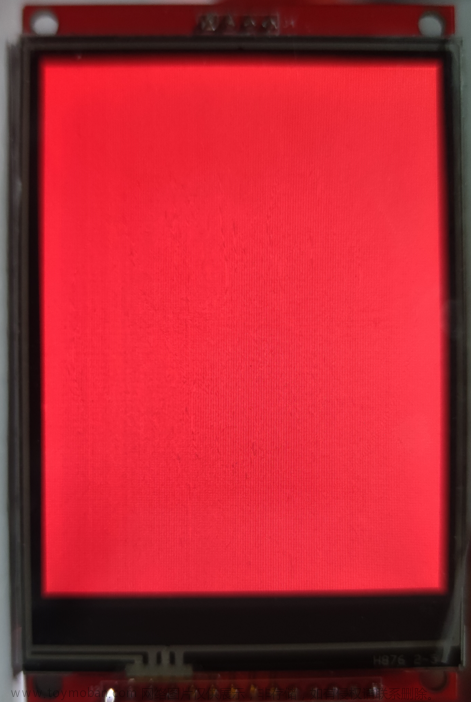
五、显示英文和动态数字
xglcd_font.py字库:
"""XGLCD Font Utility."""
from math import ceil, floor
class XglcdFont(object):
"""Font data in X-GLCD format.
Attributes:
letters: A bytearray of letters (columns consist of bytes)
width: Maximum pixel width of font
height: Pixel height of font
start_letter: ASCII number of first letter
height_bytes: How many bytes comprises letter height
Note:
Font files can be generated with the free version of MikroElektronika
GLCD Font Creator: www.mikroe.com/glcd-font-creator
The font file must be in X-GLCD 'C' format.
To save text files from this font creator program in Win7 or higher
you must use XP compatibility mode or you can just use the clipboard.
"""
# Dict to tranlate bitwise values to byte position
BIT_POS = {1: 0, 2: 2, 4: 4, 8: 6, 16: 8, 32: 10, 64: 12, 128: 14, 256: 16}
def __init__(self, path, width, height, start_letter=32, letter_count=96):
"""Constructor for X-GLCD Font object.
Args:
path (string): Full path of font file
width (int): Maximum width in pixels of each letter
height (int): Height in pixels of each letter
start_letter (int): First ACII letter. Default is 32.
letter_count (int): Total number of letters. Default is 96.
"""
self.width = width
self.height = height
self.start_letter = start_letter
self.letter_count = letter_count
self.bytes_per_letter = (floor(
(self.height - 1) / 8) + 1) * self.width + 1
self.__load_xglcd_font(path)
def __load_xglcd_font(self, path):
"""Load X-GLCD font data from text file.
Args:
path (string): Full path of font file.
"""
bytes_per_letter = self.bytes_per_letter
# Buffer to hold letter byte values
self.letters = bytearray(bytes_per_letter * self.letter_count)
mv = memoryview(self.letters)
offset = 0
with open(path, 'r') as f:
for line in f:
# Skip lines that do not start with hex values
line = line.strip()
if len(line) == 0 or line[0:2] != '0x':
continue
# Remove comments
comment = line.find('//')
if comment != -1:
line = line[0:comment].strip()
# Remove trailing commas
if line.endswith(','):
line = line[0:len(line) - 1]
# Convert hex strings to bytearray and insert in to letters
mv[offset: offset + bytes_per_letter] = bytearray(
int(b, 16) for b in line.split(','))
offset += bytes_per_letter
def lit_bits(self, n):
"""Return positions of 1 bits only."""
while n:
b = n & (~n+1)
yield self.BIT_POS[b]
n ^= b
def get_letter(self, letter, color, background=0, landscape=False):
"""Convert letter byte data to pixels.
Args:
letter (string): Letter to return (must exist within font).
color (int): RGB565 color value.
background (int): RGB565 background color (default: black).
landscape (bool): Orientation (default: False = portrait)
Returns:
(bytearray): Pixel data.
(int, int): Letter width and height.
"""
# Get index of letter
letter_ord = ord(letter) - self.start_letter
# Confirm font contains letter
if letter_ord >= self.letter_count:
print('Font does not contain character: ' + letter)
return b'', 0, 0
bytes_per_letter = self.bytes_per_letter
offset = letter_ord * bytes_per_letter
mv = memoryview(self.letters[offset:offset + bytes_per_letter])
# Get width of letter (specified by first byte)
letter_width = mv[0]
letter_height = self.height
# Get size in bytes of specified letter
letter_size = letter_height * letter_width
# Create buffer (double size to accommodate 16 bit colors)
if background:
buf = bytearray(background.to_bytes(2, 'big') * letter_size)
else:
buf = bytearray(letter_size * 2)
msb, lsb = color.to_bytes(2, 'big')
if landscape:
# Populate buffer in order for landscape
pos = (letter_size * 2) - (letter_height * 2)
lh = letter_height
# Loop through letter byte data and convert to pixel data
for b in mv[1:]:
# Process only colored bits
for bit in self.lit_bits(b):
buf[bit + pos] = msb
buf[bit + pos + 1] = lsb
if lh > 8:
# Increment position by double byte
pos += 16
lh -= 8
else:
# Descrease position to start of previous column
pos -= (letter_height * 4) - (lh * 2)
lh = letter_height
else:
# Populate buffer in order for portrait
col = 0 # Set column to first column
bytes_per_letter = ceil(letter_height / 8)
letter_byte = 0
# Loop through letter byte data and convert to pixel data
for b in mv[1:]:
# Process only colored bits
segment_size = letter_byte * letter_width * 16
for bit in self.lit_bits(b):
pos = (bit * letter_width) + (col * 2) + segment_size
buf[pos] = msb
pos = (bit * letter_width) + (col * 2) + 1 + segment_size
buf[pos] = lsb
letter_byte += 1
if letter_byte + 1 > bytes_per_letter:
col += 1
letter_byte = 0
return buf, letter_width, letter_height
def measure_text(self, text, spacing=1):
"""Measure length of text string in pixels.
Args:
text (string): Text string to measure
spacing (optional int): Pixel spacing between letters. Default: 1.
Returns:
int: length of text
"""
length = 0
for letter in text:
# Get index of letter
letter_ord = ord(letter) - self.start_letter
offset = letter_ord * self.bytes_per_letter
# Add length of letter and spacing
length += self.letters[offset] + spacing
return length
演示代码:
from machine import Pin,SPI
from ili9341 import Display,color565
from xglcd_font import XglcdFont
import time
# 创建SPI对象
spi = SPI(2, baudrate=40000000, polarity=0, phase=0, bits=8, firstbit=0, sck=Pin(18), mosi=Pin(23), miso=Pin(19))
# 创建屏幕对象
tft = Display(spi,cs=Pin(5,Pin.OUT),dc=Pin(26,Pin.OUT),rst=Pin(27,Pin.OUT),width=240,height=320,rotation=180)
# 挂载字库
fonts9x11 = XglcdFont("font/ArcadePix9x11.c",9,11)
fonts12x24 = XglcdFont("font/Unispace12x24.c",12,24)
def main():
tft.clear(color565(255,0,0))
# 在屏幕0行0列显示8x8像素的字,黑底白字
tft.draw_text8x8(0, 0, "Welcome", color565(255,255,255), color565(0,0,0))
# 在屏幕0行10列显示9x11像素的字,绿字黑底
tft.draw_text(0,10,"China",fonts9x11,color565(0,255,0))
# 在屏幕0行10列显示12x24像素的字,蓝字黑底
tft.draw_text(0,20,"BeiJing",fonts12x24,color565(0,0,255))
# 显示动态数字
while True:
for i in range(100):
tft.draw_text(0,50,"Number = %.3d"%i,fonts12x24,color565(0,0,255))
time.sleep_ms(300);
if __name__ == "__main__":
main()
显示效果为:

六、显示汉字
我们新建一个fonts.py文件用来存放字模:
class Chine:
chine = [
0x00,0x40,0x40,0x40,0x40,0x40,0xC0,0x00,0x00,0xFC,0x00,0x00,0x00,0x00,0x00,0x00,
0x00,0x04,0x18,0xE0,0xC0,0x3F,0x00,0xE0,0x1F,0x02,0xF2,0x02,0x02,0x1E,0x06,0x00,
0x00,0x00,0xC0,0x38,0x07,0x78,0xC0,0x00,0x00,0xFC,0x03,0x7C,0x80,0x00,0x00,0x00,
0x00,0x06,0x01,0x00,0x00,0x20,0x11,0x0C,0x03,0x00,0x00,0x00,0x07,0x1C,0x10,0x00,#欢0#
0x00,0x00,0x18,0xE0,0x00,0x00,0xE0,0x20,0x10,0x1C,0xC0,0x80,0x80,0xC0,0x00,0x00,
0x00,0x20,0x20,0xF9,0x00,0x00,0xFF,0x00,0x00,0x00,0xFF,0x00,0x00,0xFF,0x00,0x00,
0x00,0x00,0x00,0xFF,0x00,0x00,0x3F,0x08,0x04,0x02,0xFF,0x10,0x10,0x3F,0x00,0x00,
0x00,0x0E,0x03,0x00,0x03,0x04,0x08,0x18,0x18,0x18,0x1B,0x18,0x18,0x18,0x08,0x00,#迎1#
0x00,0x00,0x80,0x80,0x80,0x80,0x80,0xFC,0x88,0x80,0x80,0x80,0x80,0xC0,0x00,0x00,
0x00,0x00,0x00,0x02,0x1C,0x78,0x00,0xFF,0x00,0x80,0x60,0x1C,0x04,0x80,0x80,0x00,
0x00,0x01,0x01,0x01,0x81,0xE1,0x1D,0xFF,0x01,0x1F,0x61,0x81,0x01,0x01,0x01,0x00,
0x00,0x20,0x18,0x04,0x03,0x00,0x00,0x7F,0x00,0x00,0x00,0x01,0x07,0x0E,0x0C,0x00,#来2#
0x00,0x10,0x10,0x10,0x90,0xF0,0x10,0x10,0x18,0x00,0x40,0x80,0x00,0xF4,0x08,0x00,
0x00,0x00,0x70,0x2C,0x23,0xD0,0x10,0x16,0x78,0x00,0xFF,0x00,0x00,0xFF,0x00,0x00,
0x00,0x08,0x08,0x08,0x08,0xFF,0x08,0x08,0x0C,0x00,0xFF,0x00,0x00,0xFF,0x00,0x00,
0x00,0x10,0x18,0x18,0x08,0x07,0x04,0x02,0x02,0x00,0x00,0x10,0x30,0x7F,0x00,0x00,#到3#
0x00,0x00,0x00,0x00,0x00,0x00,0x00,0xFC,0x08,0x00,0x00,0x00,0x00,0x00,0x00,0x00,
0x00,0x00,0xFF,0x02,0x02,0x02,0x02,0xFF,0x02,0x02,0x02,0x02,0x02,0xFF,0x00,0x00,
0x00,0x00,0x1F,0x04,0x04,0x04,0x04,0xFF,0x04,0x04,0x04,0x04,0x04,0x1F,0x00,0x00,
0x00,0x00,0x00,0x00,0x00,0x00,0x00,0x7F,0x00,0x00,0x00,0x00,0x00,0x00,0x00,0x00,#中4#
0x00,0x00,0xFC,0x08,0x88,0x88,0x88,0x88,0x88,0x88,0x88,0xC8,0x08,0xFC,0x00,0x00,
0x00,0x00,0xFF,0x00,0x00,0x40,0x40,0xFF,0x40,0x40,0x60,0x40,0x01,0xFF,0x00,0x00,
0x00,0x00,0xFF,0x40,0x80,0x80,0x80,0xFF,0x80,0x81,0x9E,0xE0,0x80,0xFF,0x00,0x00,
0x00,0x00,0x3F,0x08,0x08,0x08,0x08,0x08,0x08,0x08,0x08,0x08,0x08,0x3F,0x00,0x00,#国5#
0x00,0x00,0x00,0x00,0x00,0xFC,0x08,0x00,0x00,0xF8,0x00,0x00,0x00,0x00,0x00,0x00,
0x00,0x08,0x08,0x08,0x08,0xFF,0x00,0x00,0x00,0xFF,0x40,0x20,0x18,0x0E,0x04,0x00,
0x00,0x00,0x00,0x00,0x80,0xFF,0x00,0x00,0x00,0xFF,0x00,0x00,0x00,0x00,0xC0,0x00,
0x00,0x06,0x03,0x01,0x00,0x7F,0x00,0x00,0x00,0x1F,0x30,0x30,0x30,0x30,0x1F,0x00,#北6#
0x00,0x80,0x80,0x80,0x80,0x80,0x80,0x8C,0xF0,0x80,0x80,0x80,0x80,0xE0,0xC0,0x00,
0x00,0x00,0x00,0x00,0xF8,0x08,0x08,0x08,0x08,0x08,0x08,0xF8,0x08,0x00,0x00,0x00,
0x00,0x00,0x00,0x00,0x8F,0xC4,0x04,0x04,0xFC,0x04,0x44,0x8F,0x00,0x00,0x00,0x00,
0x00,0x20,0x18,0x06,0x03,0x10,0x30,0x70,0x0F,0x00,0x00,0x00,0x07,0x3C,0x00,0x00,#京7#
]
字模的创建方法:
使用工具 PCtoLCD2002制作,设置如下:
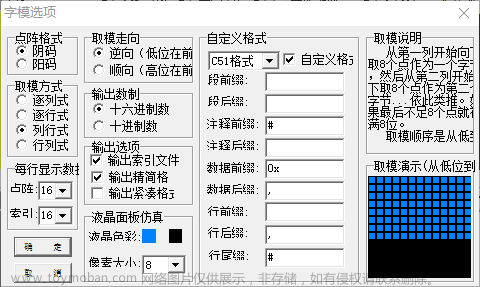
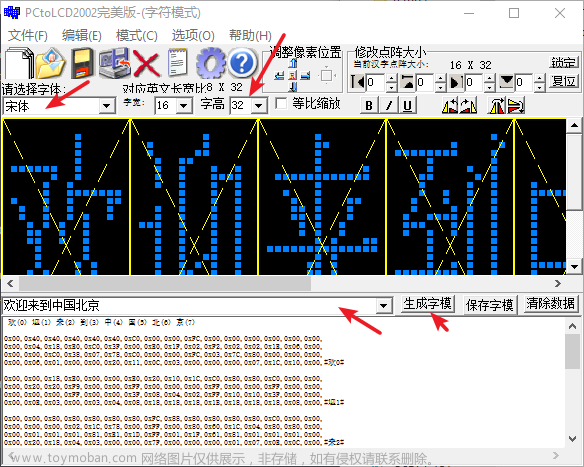
字模工具下载,请看这个文章:
物联网开发笔记(85)- 使用Micropython开发ESP32开发板之通过I2C控制0.91寸OLED液晶屏_魔都飘雪的博客-CSDN博客使用Micropython开发ESP32开发板之通过I2C控制0.91寸OLED液晶屏https://blog.csdn.net/zhusongziye/article/details/129290088?spm=1001.2014.3001.5501显示汉字代码:
from machine import Pin,SPI,PWM
from ili9341 import Display,color565
from xglcd_font import XglcdFont
from fonts import Chine
import time
# 创建SPI对象
spi = SPI(2, baudrate=40000000, polarity=0, phase=0, bits=8, firstbit=0, sck=Pin(18), mosi=Pin(23), miso=Pin(19))
# 创建屏幕对象
tft = Display(spi,cs=Pin(5,Pin.OUT),dc=Pin(26,Pin.OUT),rst=Pin(27,Pin.OUT),width=240,height=320,rotation=180)
# 挂载字库
fonts9x11 = XglcdFont("font/ArcadePix9x11.c",9,11)
fonts12x24 = XglcdFont("font/Unispace12x24.c",12,24)
#16*32字体函数
def ByteOpera16x32(num,dat):
byte= [0x01,0x02,0x04,0x8,0x10,0x20,0x40,0x80]
if dat&byte[num]:
return 1
else:
return 0
def LcdShowCh_16x32(n, x_axis, y_axis):
for i in range(4):
for a in range(16):
for b in range(8): # 8个汉字
if(ByteOpera16x32(b,Chine.chine[n*64+i*16+a])):
tft.draw_pixel(x_axis+a,y_axis+i*8+b,color565(255,0,255))
else:
tft.draw_pixel(x_axis+a,y_axis+i*8+b,color565(0,0,0))
def main():
tft.clear(color565(255,0,0))
# 在屏幕0行0列显示8x8像素的字,黑底白字
tft.draw_text8x8(0, 0, "Welcome", color565(255,255,255), color565(0,0,0))
# 在屏幕0行10列显示9x11像素的字,绿字黑底
tft.draw_text(0,10,"China",fonts9x11,color565(0,255,0))
# 在屏幕0行10列显示12x24像素的字,蓝字黑底
tft.draw_text(0,20,"BeiJing",fonts12x24,color565(0,0,255))
# 显示汉字
for i in range(8): # 8指得是8个汉字
LcdShowCh_16x32(i,i*16,50)
# 显示动态数字
while True:
for h in range(100):
tft.draw_text(0,90,"Number = %.3d" % h,fonts12x24,color565(0,0,255))
time.sleep_ms(100);
if __name__ == "__main__":
main()显示效果如下:

七、屏幕亮度调节
我们如果直接把屏幕的LED接到开发板的5V上,则为最亮的亮度。如果我们需要调节亮度,则需要使用PWM进行调光。
from machine import Pin,SPI,PWM
from ili9341 import Display,color565
from xglcd_font import XglcdFont
from fonts import Chine
import time
# 调节显示亮度,初始亮度为400
blk = PWM(Pin(2),duty = (400),freq = (1000))
# 创建SPI对象
spi = SPI(2, baudrate=40000000, polarity=0, phase=0, bits=8, firstbit=0, sck=Pin(18), mosi=Pin(23), miso=Pin(19))
# 创建屏幕对象
tft = Display(spi,cs=Pin(5,Pin.OUT),dc=Pin(26,Pin.OUT),rst=Pin(27,Pin.OUT),width=240,height=320,rotation=180)
# 挂载字库
fonts9x11 = XglcdFont("font/ArcadePix9x11.c",9,11)
fonts12x24 = XglcdFont("font/Unispace12x24.c",12,24)
#16*32字体函数
def ByteOpera16x32(num,dat):
byte= [0x01,0x02,0x04,0x8,0x10,0x20,0x40,0x80]
if dat&byte[num]:
return 1
else:
return 0
def LcdShowCh_16x32(n, x_axis, y_axis):
for i in range(4):
for a in range(16):
for b in range(8): # 8个汉字
if(ByteOpera16x32(b,Chine.chine[n*64+i*16+a])):
tft.draw_pixel(x_axis+a,y_axis+i*8+b,color565(255,0,255))
else:
tft.draw_pixel(x_axis+a,y_axis+i*8+b,color565(0,0,0))
def main():
tft.clear(color565(255,0,0))
# 在屏幕0行0列显示8x8像素的字,黑底白字
tft.draw_text8x8(0, 0, "Welcome", color565(255,255,255), color565(0,0,0))
# 在屏幕0行10列显示9x11像素的字,绿字黑底
tft.draw_text(0,10,"China",fonts9x11,color565(0,255,0))
# 在屏幕0行10列显示12x24像素的字,蓝字黑底
tft.draw_text(0,20,"BeiJing",fonts12x24,color565(0,0,255))
# 显示汉字
for i in range(8): # 8指得是8个汉字
LcdShowCh_16x32(i,i*16,50)
# 显示动态数字
while True:
for h in range(1024):
tft.draw_text(0,90,"Number = %.4d" % h,fonts12x24,color565(0,0,255))
time.sleep_ms(50);
blk.duty(h)
if __name__ == "__main__":
main()显示效果:
显示完“欢迎来到北京”后,屏幕会关掉,然后慢慢的变亮,大家动手试一下哈!
八、参考资料
Quick reference for the ESP32 — MicroPython latest documentationhttps://docs.micropython.org/en/latest/esp32/quickref.html#hardware-spi-bus
九、屏幕购买
请看我的这个文章,谢谢关注!文章来源:https://www.toymoban.com/news/detail-568966.html
物联网开发笔记(62)- 使用Micropython开发ESP32开发板之控制ILI9341 3.2寸TFT-LCD触摸屏进行LVGL图形化编程:环境搭建_micropython lvgl_魔都飘雪的博客-CSDN博客使用Micropython开发ESP32开发板之控制ILI9341 3.2寸TFT-LCD触摸屏进行LVGL图形化编程:环境搭建https://blog.csdn.net/zhusongziye/article/details/128321793?spm=1001.2014.3001.5501文章来源地址https://www.toymoban.com/news/detail-568966.html
到了这里,关于物联网开发笔记(91)- 使用Micropython开发ESP32开发板之通过串口SPI控制ILI9341 液晶屏显示文字的文章就介绍完了。如果您还想了解更多内容,请在右上角搜索TOY模板网以前的文章或继续浏览下面的相关文章,希望大家以后多多支持TOY模板网!

